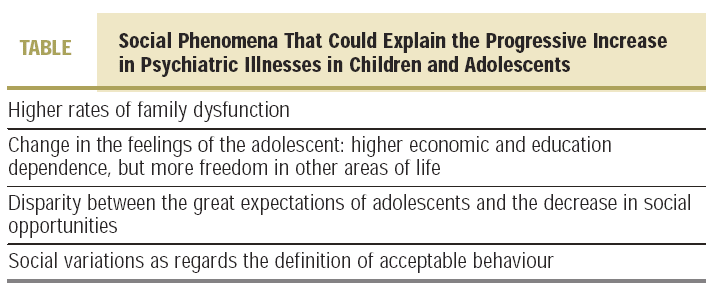Happy families are all alike, every unhappy family is unhappy in its own way.
Léon Tolstoy, Ana Karenina
It is generally accepted that psychiatric illnesses in childhood and adolescence have increased tremendously since the Second World War. This statement is based on solid data, such as the increase in the levels of drugs and alcohol consumption, the prevalence of depression and suicide, or the increase in behavioural disorders and criminal behaviour in that age group. This phenomenon is so important that some authors of the stature of Michael Rutter1 have even considered whether we will be faced with a "cohort effect," that is to say, faced with a progressive process of developing psychiatric illnesses in every new generation. Given that it is unlikely that genetic changes may have taken place that produce this phenomenon in such a short space of time, the causes that are considered to explain this process are set out in Table 1.
It is in this context of the scientific debate on the underlying causes of the evident increase in psychiatric illnesses in the first stages of life where the work of Pérez Milena et al2 has to be mentioned. With all the methodological limitations that cross-sectional studies have, this investigation stands out in being one of the first on the subject of family functioning in adolescents carried out in Spain. The main conclusion is that children and adolescents who live in dysfunctional families (as defined by the children themselves) have a higher rate of psychiatric illnesses, such as depression, or consume drugs or alcohol. Another notable finding is that, contrary to what the prevalent social prejudices might bode, as regards single parent families, the family structure "per se" (that is, whether it is nuclear, single-parent, etc) does not necessarily affect family function or psychiatric illness during adolescence. However, this last piece of data, which may contradict many other previous studies,3 will have to be evaluated with caution due to the characteristics of the tools used (fairly non-specific) or the design of the study (longitudinal studies may be required).
What does seem to be a consistent finding, is that family dysfunction is associated with psychiatric illnesses in adolescents. However, the concept of family dysfunction is not sufficiently defined. It has been described as those families who have any of the following problems4:
Non-harmonic family relationships: may include not only dysfunctional, discordant and hostile relationships between the 2 parents or between them and there children, but also other more subtle changes, such as strong or inconsistent discipline (where there is disparity between parents) or ineffective control and supervision (with lack of limits for the adolescents).
Psychiatric illness in the family: psychosis, personality disturbances, or alcohol and drug abuse in the parents is associated with a higher incidence of psychiatric illnesses in the children.
Complicated paternal divorce: divorce is associated with negative consequences, particularly if there is disagreement in the upbringing between the parents, situations of continuing conflict between them, or economic difficulties. Academic performance is the most common change, but there can also be behavioural changes, which generally may not be serious, particularly in males.
As regards preventing family dysfunction, although there are some useful guidelines that may be suitable in primary care which have been summarised by PAPPS Mental Health (Prevention and Health Promotion Program),5 it is a very complex process that requires specific home and school interventions,6 therefore their implementation may be beyond the means of the health system.
Key Points
* Psychiatric illnesses appear to be progressively increasing in each new generation.
* Family dysfunction as perceived by the adolescent correlates with the appearance of psychiatric illnesses and with alcohol and substance abuse.
* The concept of family dysfunction is not well defined, but may include families with non-harmonic relationships, paternal psychiatric illness, or complicated paternal divorce.
* Prevention of family dysfunction is a complex process that requires specific home and school interventions, and not just health approaches.








